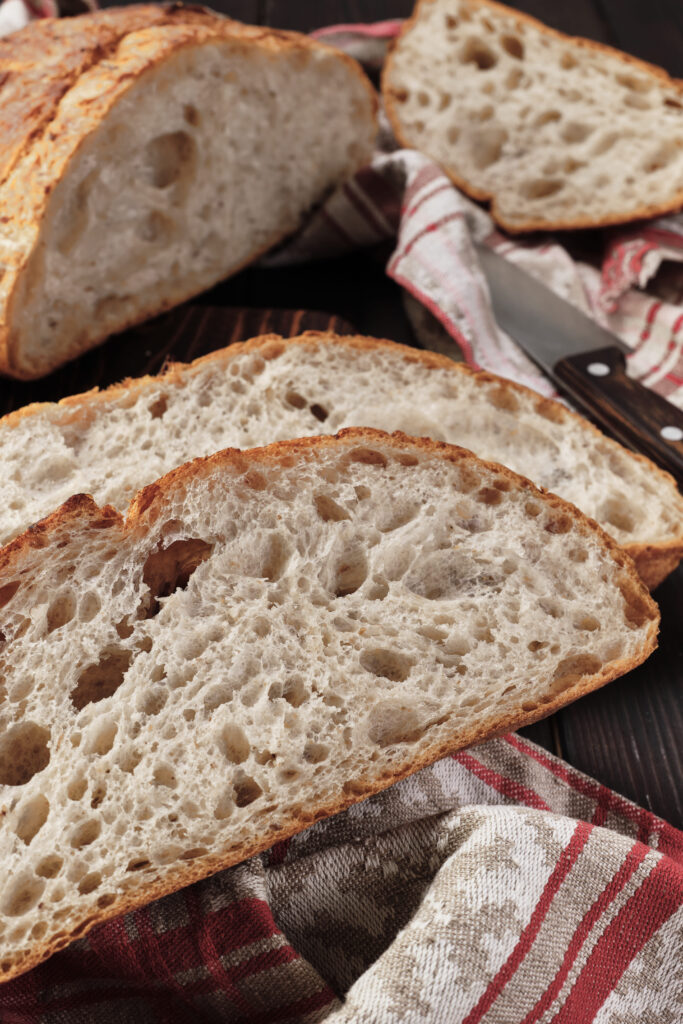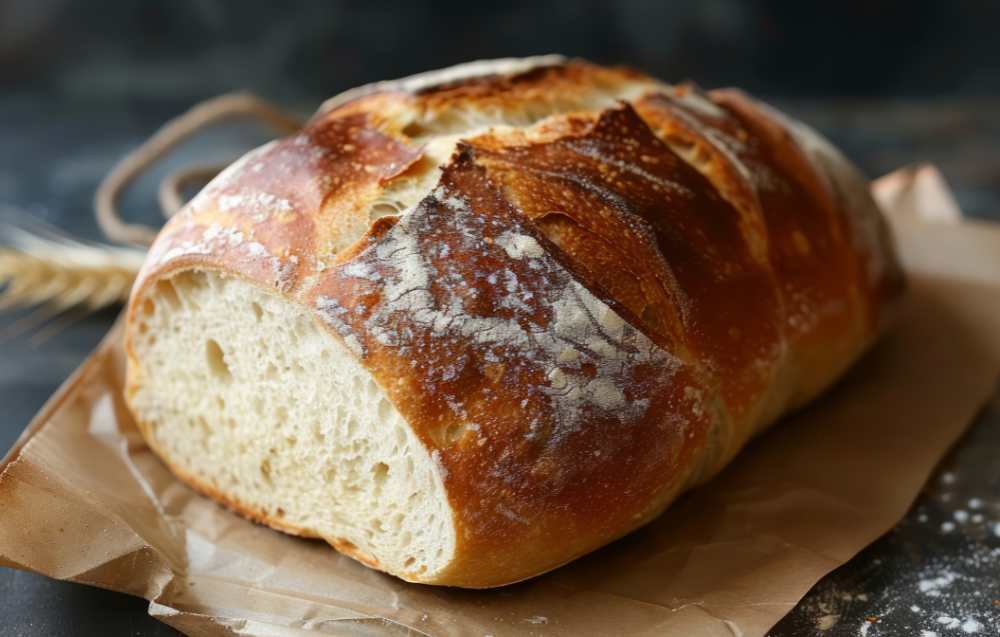When it comes to bread, there’s something undeniably magical about the rustic charm of artisan Italian bread. From the earthy, comforting aroma of a freshly baked loaf to the chewy, flavorful bite that delights your taste buds, it’s easy to see why this bread has captivated food lovers around the world. Its perfect blend of tradition and flavor makes it a true culinary treasure. In this guide, we’ll explore everything you need to know about artisan Italian bread—its rich history, the diverse varieties, and the techniques behind crafting it at home. Get ready to embark on a flavorful journey!
Introduction to Artisan Italian Bread
Artisan Italian bread is more than food—it’s an art form. Let’s explore its unique characteristics and why it’s adored around the globe.
What Defines Artisan Italian Bread?
Have you ever wondered what makes artisan Italian bread so extraordinary? It’s far more than just bread—it’s a labor of love, steeped in rich tradition and masterful craftsmanship. Unlike the uniform, mass-produced loaves you find on grocery store shelves, artisan bread is created in small batches, using only the finest ingredients. Every step of the process, from mixing and kneading to proofing and baking, is done with meticulous care. This dedication results in a rustic, flavorful loaf that’s as beautiful to look at as it is to eat. With its perfect golden crust and tender, airy crumb, each bite delivers a symphony of texture and taste. But artisan Italian bread isn’t just about satisfying hunger; it’s about celebrating a centuries-old art form. Every loaf tells a story of heritage and passion, reminding us that food can be as much about connection and culture as it is about nourishment.

Why Is Artisan Italian Bread So Popular?
Why does everyone rave about it? For starters, it’s incredibly versatile. Whether you’re mopping up a hearty pasta sauce or crafting the perfect panini, this bread shines in any role. Pair it with dishes like Tini Mac and Cheese Recipe for a delightful combination of creamy and crusty textures.
A Historical Journey Through Italian Bread-Making
Italian bread has a history as rich and textured as its crust. Let’s take a closer look.
Ancient Origins of Italian Bread
The history of Italian bread stretches back thousands of years, with its roots firmly planted in ancient Rome. The Romans were pioneers in bread-making, using stone-ground flour and rudimentary ovens to create hearty, nourishing loaves. Bread was far more than a basic food; it was a cornerstone of Roman society, symbolizing progress and the foundation of civilization. It played a vital role in daily life, from humble households to grand feasts, reflecting the ingenuity and cultural values of the time. This enduring tradition laid the groundwork for the artisanal breads we cherish today, linking past to present in every loaf.
Evolution of Artisan Techniques Over the Centuries
Over the centuries, Italian bakers have refined their craft into an art form, preserving tradition while embracing innovation. Techniques were carefully passed down through generations, ensuring that the knowledge and passion for bread-making endured. The introduction of sourdough starters revolutionized the process, enhancing both flavor and texture. Wood-fired ovens brought a new depth to baking, creating loaves with perfectly crisp crusts and smoky undertones. Regional ingredients, such as locally milled flour and fresh olive oil, added unique characteristics to each loaf, reflecting Italy’s diverse culinary heritage. Together, these elements shaped the evolution of artisan Italian bread into a timeless masterpiece.
Types of Artisan Italian Bread
Italy’s diverse regions offer a variety of breads, each with its own unique flavor and story.
Ciabatta: The Modern Classic
Ciabatta is a staple in many kitchens. Its airy crumb and crisp crust make it ideal for sandwiches. Consider pairing ciabatta with a hearty filling like brisket, as discussed in Brisket Sandwich Recipes.
Pane Toscano: Tuscany’s Saltless Bread
If you’ve ever tasted pane Toscano, you might notice it’s missing something: salt. This bread’s unique flavor comes from its salt-free recipe. It pairs beautifully with cured meats or salty cheeses, much like those highlighted in Best Cheese for Brisket Sandwich.
The Art of Making Artisan Italian Bread
Making artisan Italian bread is more than a recipe; it’s a journey. With the right techniques, you can turn simple ingredients into a loaf that’s both a feast for the eyes and a delight for the palate. Let’s dive into the process.
Kneading Techniques for Perfect Dough
Kneading is essential for developing gluten—the protein that gives bread its structure and elasticity. Whether you’re kneading by hand or using a stand mixer, aim for a dough that feels smooth and slightly tacky. Think of kneading as giving your dough a massage—it’s all about finding the right pressure and rhythm. For a deeper understanding of traditional methods, explore the Origins of Bread-Making in Ancient Rome.
Here’s a quick tip: Perform the windowpane test to check gluten development. Stretch a piece of dough between your fingers. If it doesn’t tear and forms a translucent sheet, you’re ready to move on!
Proofing: Achieving the Ideal Rise
Proofing is where the magic of fermentation happens. During this stage, yeast feeds on sugars, releasing carbon dioxide that causes the dough to rise. The result? A light, airy loaf with complex flavors. Proofing requires patience—it’s like letting your dough take a well-deserved nap before the big show.
To ensure consistent results, pay attention to your environment. A slightly warm, draft-free spot is ideal. Some bakers even use the refrigerator for a cold ferment, which allows flavors to develop over time. For more details on this transformative process, check out the Importance of Fermentation in Artisan Bread.
Shaping and Baking: From Dough to Loaf
Once your dough has risen, it’s time to shape it. This step determines the final appearance of your bread. Whether you’re crafting a round boule, a rustic baguette, or a focaccia masterpiece, handle the dough gently to preserve its structure. After shaping, give the dough a final proof to let it relax and settle.
Baking artisan bread is best done in a high-temperature environment. A wood-fired oven is traditional, offering consistent heat and a smoky flavor that’s hard to replicate. If you’re curious about the benefits of wood-fired ovens and want to try a similar method at home, learn more at Benefits of Baking in Wood-Fired Ovens.
The Importance of Tools and Techniques
The tools you use can elevate your bread-making experience. Here are some must-haves for artisan Italian bread:
- A pizza stone or baking steel for consistent heat distribution.
- A Dutch oven to trap steam, creating a perfect crust.
- A bench scraper for clean, precise dough handling.
Steam is another game-changer. By adding moisture during the first few minutes of baking, you’ll achieve that iconic crispy crust.
“Great bread isn’t just about the recipe—it’s about the details. From kneading to baking, every step matters.”
Common Problems in Artisan Bread-Making
Even the most experienced bakers encounter challenges when making artisan bread. The good news? Most issues have simple solutions. Let’s tackle some common problems and how to fix them.
Why Is My Dough Not Rising?
A stubborn dough that refuses to rise can be frustrating. This usually happens because of:
- Inactive or expired yeast.
- Using water that’s too hot or too cold.
- Proofing in a cold environment.
To fix this, always check your yeast before starting. Dissolve it in warm water with a pinch of sugar—if it bubbles within 10 minutes, it’s active. Also, create a warm proofing environment by placing the dough near a window or inside an oven with the light on.
Troubleshooting Overly Dense Bread
Dense bread can feel like a letdown after all your hard work. This often results from:
- Under-kneading, which prevents gluten development.
- Insufficient proofing, leaving the dough too tight.
The fix? Knead your dough until it passes the windowpane test and proof it until it doubles in size. Remember, bread-making is about patience—let the dough take its time.
Avoiding Burnt or Uneven Crusts
Nothing’s worse than a burnt crust and an undercooked interior. This happens when:
- The oven temperature is too high.
- The bread is placed too close to the heat source.
Use an oven thermometer to ensure accurate temperatures and bake on the middle rack for even heat distribution. If you notice the crust browning too quickly, cover it with foil for the remainder of the bake.
Solutions and Tips for Perfect Artisan Italian Bread
Mastering the Art of Timing
Timing is crucial in bread-making, as each stage—from kneading to proofing to baking—relies on precision. Developing a consistent rhythm is key to success. If a recipe suggests kneading for 30 minutes or proofing for 3 hours, follow it closely to ensure the best results. Rushing any step can compromise the bread’s texture and flavor, while patience allows the dough to develop fully. Each phase has a purpose: kneading builds gluten, proofing lets the dough rise and ferment, and baking transforms it into a golden masterpiece. Remember, great bread isn’t rushed—it’s a reward for those who take their time.
The Role of Temperature in Every Stage
Temperature affects every aspect of bread-making:
- Kneading: Warm water activates yeast, while cold water slows fermentation.
- Proofing: Dough rises best in a slightly warm, humid environment.
- Baking: Preheat your oven fully to achieve a perfect crust.
Control the temperature, and you control the bread.
Experimenting with Variations
Once you’ve nailed the basics of bread-making, it’s time to get creative! Experiment with adding ingredients like olives, fresh herbs, or seeds to infuse your dough with new flavors and textures. Consider incorporating sun-dried tomatoes or roasted garlic for a Mediterranean twist. You can also play with shapes and sizes—try braiding the dough, shaping it into rolls, or even crafting a decorative boule. Artisan bread offers endless possibilities, blending tradition with personal flair. Don’t be afraid to take risks; every loaf tells a unique story. Remember, the beauty of artisan bread lies in both its creativity and its heritage.
Celebrating Artisan Italian Bread
Bread as a Cultural Icon
Artisan Italian bread is far more than just sustenance—it embodies Italy’s rich cultural heritage. Each loaf tells a story, weaving together the traditions of regions across the country. The salt-free pane Toscano reflects centuries-old customs in Tuscany, while the olive oil-infused focaccia captures the flavors of the Mediterranean. These breads are more than recipes; they are living links to the past, connecting us to generations of Italian bakers who honed their craft with care and precision. Every slice carries a piece of history, a reminder of the timeless art of bread-making and its deep roots in Italian culture.
Why Everyone Should Try Making It
Making artisan Italian bread at home is more than just a culinary endeavor—it’s a transformative experience. The process teaches patience as you wait for the dough to rise and fosters creativity as you experiment with flavors and techniques. There’s an undeniable sense of accomplishment in crafting something so traditional and beautiful with your own hands. As your kitchen fills with the warm, comforting aroma of freshly baked bread, the anticipation builds. Finally, slicing into a crusty, golden loaf that you’ve created is a uniquely satisfying moment. It’s not just bread—it’s a labor of love that nourishes both body and soul.
“Artisan bread-making is a journey—a delicious blend of science, art, and tradition that nourishes both the body and soul.”
Looking to the Future
As traditional methods and wholesome ingredients gain renewed appreciation, artisan Italian bread is becoming more popular than ever. Its timeless charm appeals to bakers and food lovers alike, whether it’s crafted in a rustic wood-fired oven or in the comfort of your home kitchen. Baking this bread isn’t just about creating a delicious loaf—it’s about connecting with history and honoring the art passed down through generations. Every loaf preserves a piece of culinary tradition, blending craftsmanship with simplicity. By making artisan Italian bread yourself, you’re contributing to the legacy of a food that continues to inspire and delight the world.
Artisan Italian bread is a gift from Italy to the world, offering flavor, culture, and craftsmanship in every bite. Whether you’re a beginner or an experienced baker, the journey to mastering this bread is as rewarding as the result. So roll up your sleeves, dust off some flour, and let the magic begin!

